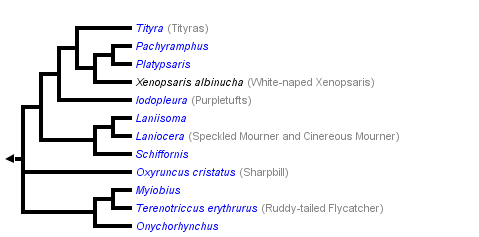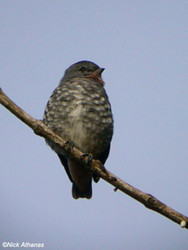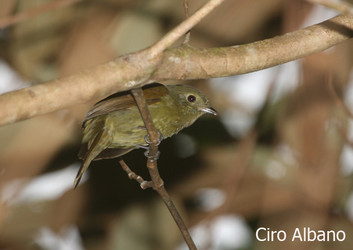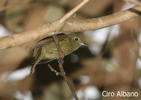Tityridae
John Harshman


This tree diagram shows the relationships between several groups of organisms.
The root of the current tree connects the organisms featured in this tree to their containing group and the rest of the Tree of Life. The basal branching point in the tree represents the ancestor of the other groups in the tree. This ancestor diversified over time into several descendent subgroups, which are represented as internal nodes and terminal taxa to the right.

You can click on the root to travel down the Tree of Life all the way to the root of all Life, and you can click on the names of descendent subgroups to travel up the Tree of Life all the way to individual species.
For more information on ToL tree formatting, please see Interpreting the Tree or Classification. To learn more about phylogenetic trees, please visit our Phylogenetic Biology pages.
close boxDiscussion of Phylogenetic Relationships
Sibley and Ahlquist (1985) established the new subfamily Tityrinae to include several taxa removed from traditional families, and it has been subsequently expanded to a family (Ericson et al. 2006, Ohlson et al. 2008, Tello et al. 2009), now including taxa from Tyrannidae (Tityra, Xenopsaris, Pachyramphus, Laniocera — though these were sometimes placed in Cotingidae too —Myiobius, Terenotriccus, Onychorhynchus), Cotingidae (Iodopleura, Laniisoma), and Pipridae (Schiffornis). Oxyruncus (sharpbill) has sometimes been placed in Tyrannidae or Cotingidae, and sometimes given its own family, Oxyruncidae.References
Barber, B. R. and N. H. Rice. 2007. Systematics and evolution in the Tityrinae (Passeriformes : Tyrannoidea). Auk 124(4):1317-1329.
Chesser, R. T. 2004. Molecular systematics of New World suboscine birds. Mol. Phylogen. Evol. 32:11-24.
Ericson, P. G. P., D. Zuccon, J. I. Ohlson, U. S. Johansson, H. Alvarenga, and R. O. Prum. 2006. Higher-level phylogeny and morphological evolution of tyrant flycatchers, cotingas, manakins, and their allies (Aves: Tyrannida). Molecular Phylogenetics and Evolution 40:4711-483.
Johansson, U. S., M. Irestedt, T. J. Parsons, and P. G. P. Ericson. 2002. Basal phylogeny of the Tyrannoidea based on comparisons of cytochrome b and exons of nuclear c-myc and RAG-1 genes. Auk 119:984-995.
Ohlson, J., J. Fjeldså, and P. G. P. Ericson. 2008. Tyrant flycatchers coming out in the open: Phylogeny and ecological radiation of Tyrannidae (Aves, Passeriformes). Zoologica Scripta 37:315-335.
Prum, R.O. 1990. A test of the monophyly of the manakins (Pipridae) and of the cotingas (Cotingidae) based on morphology. Occ. Papers Museum of Zoology, Univ. of Michigan 723:1-44.
Prum, R.O. and W. E. Lanyon. 1989. Monophyly and phylogeny of the Schiffornis group (Tyrannoidea). Condor 91:444–461.
Prum, R. O., Rice, N. H., Mobley, J. A., and Dimmick, W. W. 2000. A preliminary phylogenetic hypothesis for the cotingas (Cotingidae) based on mitochondrial DNA. Auk 117: 236-241.
Sibley, C. G., and J. E. Ahlquist. 1985. Phylogeny and classification of New World suboscine passerines (Passeriformes: Oligomyodi: Tyrannides). Ornithol. Monogr. 36:396-430.
Tello, J. G., R. G. Moyle, D. J. Marchese, and J. Cracraft. 2009. Phylogeny and phylogenetic classification of the tyrant flycatchers, cotinga, manakins, and their allies (Aves: Tyrannides). Cladistics 25:1-39.
Title Illustrations

| Scientific Name | Iodopleura pipra |
|---|---|
| Location | Angelim Reserve, São Paulo state, Brazil |
| Comments | This one is endemic to the lowland rainforests of Brazil, a habitat that has been reduced to a tiny fraction of it's original extent. Fortunately they are still easy to see in a few places. |
| Specimen Condition | Live Specimen |
| Copyright | © Nick Athanas |
| Scientific Name | Schiffornis virescens |
|---|---|
| Location | Mata úmida de Boa Nova, Bahia, Brazil |
| Specimen Condition | Live Specimen |
| Source | Schiffornis virescens_Greenish Schiffornis |
| Source Collection | Flickr |
| Copyright |
© 2008 Ciro Albano

|
| Scientific Name | Tityra semifasciata |
|---|---|
| Location | along the forest trail north of Sangayta, Nayarit, Mexico |
| Specimen Condition | Live Specimen |
| Source | WMex09_D-40-0568a |
| Source Collection | Flickr |
| Image Use |
 This media file is licensed under the Creative Commons Attribution-NonCommercial-ShareAlike License - Version 2.0. This media file is licensed under the Creative Commons Attribution-NonCommercial-ShareAlike License - Version 2.0.
|
| Copyright | © 2009 Jerry Oldenettel |
About This Page
Correspondence regarding this page should be directed to John Harshman at
Page copyright © 2009
 Page: Tree of Life
Tityridae.
Authored by
John Harshman.
The TEXT of this page is licensed under the
Creative Commons Attribution-NonCommercial License - Version 3.0. Note that images and other media
featured on this page are each governed by their own license, and they may or may not be available
for reuse. Click on an image or a media link to access the media data window, which provides the
relevant licensing information. For the general terms and conditions of ToL material reuse and
redistribution, please see the Tree of Life Copyright
Policies.
Page: Tree of Life
Tityridae.
Authored by
John Harshman.
The TEXT of this page is licensed under the
Creative Commons Attribution-NonCommercial License - Version 3.0. Note that images and other media
featured on this page are each governed by their own license, and they may or may not be available
for reuse. Click on an image or a media link to access the media data window, which provides the
relevant licensing information. For the general terms and conditions of ToL material reuse and
redistribution, please see the Tree of Life Copyright
Policies.
- First online 28 November 2009
- Content changed 28 November 2009
Citing this page:
Harshman, John. 2009. Tityridae. Version 28 November 2009 (under construction). http://tolweb.org/Tityridae/67996/2009.11.28 in The Tree of Life Web Project, http://tolweb.org/











 Go to quick links
Go to quick search
Go to navigation for this section of the ToL site
Go to detailed links for the ToL site
Go to quick links
Go to quick search
Go to navigation for this section of the ToL site
Go to detailed links for the ToL site